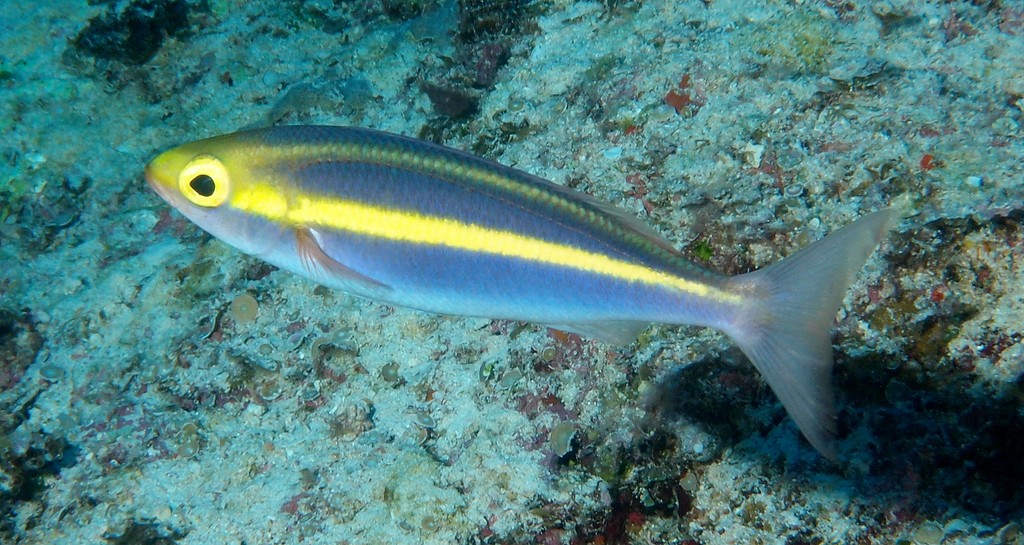PENTAPODUS CANINUS - (CUVIER, 1830)
Actinopterygii (Gigaclass) > Actinopteri (Class) > Teleostei (Subclass) > Acanthuriformes (Order) > Nemipteridae (Family) > Pentapodus (Genus)
Scolopside à dents canines, Canine-toothed mid-water bream, Redfin mid-water bream, Small-toothed threadfin-bream, Threadtail bream, Small-toothed whiptail, Kitsun-un, Kitsune-uo, キツネウオ, 大尾錐齒鯛, 斑鰭白姑魚,
Synonymes
Dampieria hellmuthii (Bleeker, 1853)
Heterognathodon hellmuthii (Bleeker, 1853)
Heterognathodon macrurus (Bleeker, 1849)
Heterognathodon microdon (Bleeker, 1853)
Pentapodus macrurus (Bleeker, 1849)
Pentapodus microdon (Bleeker, 1853)
Pentapus formulosus (Snyder, 1913)
Scolopsides caninus (Cuvier, 1830)
-----------------------------
Description
Dorsal spines (total): 10; Dorsal soft rays (total): 9; Anal spines: 3; Anal soft rays: 7; Pectoral fin rays: 13-15; Lateral line scales: 43-47. Head scales reaching forward to or just in front of level of anterior nostrils. Scaled area between nostrils with a distinct naked medial wedge-shaped notch. Suborbital scaly posteriorly. Scales rows on cheek: 4-5; Enlarged canines on jaws; Lower limb of preopercle with 2-3 scale rows. Pelvic fins moderately long, reaching to or almost to level of anus. Caudal fin tips very acute, upper lobe distinctly longer than lower. Axillary scale present. Max. length: 35.0 cm TL, common length: 15.0 cm SL. Depth range: 2 - 35 m.
Color
Body biolet blue, darker above; Narrow yellow line above lateral line from eye to upper caudal peduncle, broad yellow band mid-laterally from eye to caudal fin base; Narrow blue line from upper lip passes under eye and across operculum. Fins pink, caudal fin edged darker.
Etymology
Pentapodus: from ancient Greek, pénte = five + from Greek, podus or podos = feet. According to Valenciennes (1835), who called the genus “Pentapus,” referring to three long, pointed scales, one above root of each ventral fin and a single one between them, appearing like five ventral fins.
Scolopside à dents canines, Canine-toothed mid-water bream, Redfin mid-water bream, Small-toothed threadfin-bream, Threadtail bream, Small-toothed whiptail, Kitsun-un, Kitsune-uo, キツネウオ, 大尾錐齒鯛, 斑鰭白姑魚,
Synonymes
Dampieria hellmuthii (Bleeker, 1853)
Heterognathodon hellmuthii (Bleeker, 1853)
Heterognathodon macrurus (Bleeker, 1849)
Heterognathodon microdon (Bleeker, 1853)
Pentapodus macrurus (Bleeker, 1849)
Pentapodus microdon (Bleeker, 1853)
Pentapus formulosus (Snyder, 1913)
Scolopsides caninus (Cuvier, 1830)
-----------------------------
Description
Dorsal spines (total): 10; Dorsal soft rays (total): 9; Anal spines: 3; Anal soft rays: 7; Pectoral fin rays: 13-15; Lateral line scales: 43-47. Head scales reaching forward to or just in front of level of anterior nostrils. Scaled area between nostrils with a distinct naked medial wedge-shaped notch. Suborbital scaly posteriorly. Scales rows on cheek: 4-5; Enlarged canines on jaws; Lower limb of preopercle with 2-3 scale rows. Pelvic fins moderately long, reaching to or almost to level of anus. Caudal fin tips very acute, upper lobe distinctly longer than lower. Axillary scale present. Max. length: 35.0 cm TL, common length: 15.0 cm SL. Depth range: 2 - 35 m.
Color
Body biolet blue, darker above; Narrow yellow line above lateral line from eye to upper caudal peduncle, broad yellow band mid-laterally from eye to caudal fin base; Narrow blue line from upper lip passes under eye and across operculum. Fins pink, caudal fin edged darker.
Etymology
Pentapodus: from ancient Greek, pénte = five + from Greek, podus or podos = feet. According to Valenciennes (1835), who called the genus “Pentapus,” referring to three long, pointed scales, one above root of each ventral fin and a single one between them, appearing like five ventral fins.
caninus: from Latin, canis = dog + from Latin suffix, -inus = of or pertaining to; Usually indicates a relationship of position, possession, or origin. Named for its long teeth like a dog.
Original description: Scolopsides caninus Cuvier, 1830 - Type locality: Havre-Dorey, New Guinea.
Distribution
Western Pacific: Indonesia, east to Marshall Islands and New Ireland (Papua New Guinea), north to southern Japan, south to northern Australia and New Caledonia.
Biology
Usually found close to the bottom over coral reef areas. Feeds on small fishes and larger zooplankton, as well as on benthic organisms. Occurs solitary or in small groups.
Similar species
Original description: Scolopsides caninus Cuvier, 1830 - Type locality: Havre-Dorey, New Guinea.
Distribution
Western Pacific: Indonesia, east to Marshall Islands and New Ireland (Papua New Guinea), north to southern Japan, south to northern Australia and New Caledonia.
Biology
Usually found close to the bottom over coral reef areas. Feeds on small fishes and larger zooplankton, as well as on benthic organisms. Occurs solitary or in small groups.
Similar species
- Pentapodus aureofasciatus (Russel, 2001) - Reported from New Caledonia - Link to the species (here).
- Pentapodus berryae (Allen, Erdmann & Brooks, 2018) - Reported from Western Pacific: East Cape area, Milne Bay (Papua New Guinea).
- Pentapodus emeryii (Richardson, 1843) - Reported from Eastern Indian Ocean and western Pacific: Brunei, Malaysia and Indonesia, east to Philippines and New Ireland (Papua New Guinea), south to northern Western Australia. The difference is with the width of the stripes. The Pentapodus aureofasciatus has stripes of equal size on back and side. The Pentapodus emeryii has a wider mid-lateral stripes.
- Pentapodus komodoensis (Allen & Erdmann, 2012) - Reported from Eastern indian Ocean: Komodo (Indonesia) endemic.
Last update: 12, October 2024
